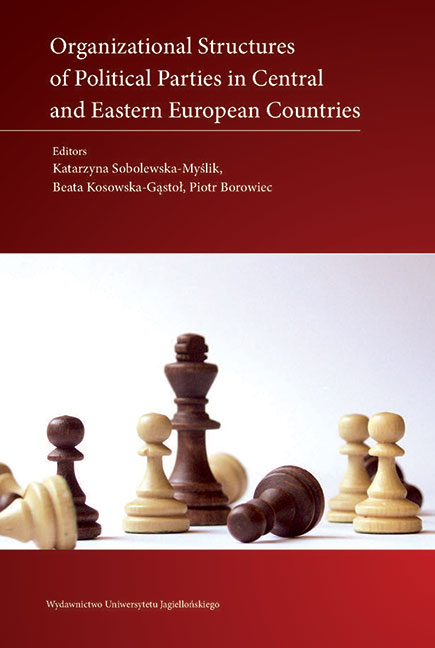Book contents
- Frontmatter
- Contents
- Preface
- Developing Party Structures in Central and Eastern Europe
- Albania: Organizations of Political Parties in Albania
- Belarus: Belarusian Political Parties: Organizational Structures and Practices
- Bosnia and Herzegovina: Organizational Structures of Political Parties in CEE Countries: A Case Study on Bosnia and Herzegovina
- Bulgaria: Organizational Structure and Trends in Bulgarian Party Politics
- Croatia: Organizational Structures of Political Parties in Croatia
- Czech Republic: Between Organizational Extremes: Czech Parties after a Political Earthquake
- Estonia: Organizational Structures of Political Parties in Estonia
- Hungary: Cut from the Same Cloth? A Comparative Analysis of Party Organizations in Hungary
- Kosovo: Structure of the Main Political Parties in Kosovo
- Latvia: Leader-Centered and Power-Hungry: Party Organizations in Latvia
- Lithuania: Organization of Political Parties: The Case of Lithuania
- Moldova: Organizational Structures of Political Parties in The Republic of Moldova
- Montenegro: Party Organization in Montenegro: Structural Resemblance Behind Political Divergence
- Poland: Structures of Polish Political Parties in the Second Decade of the 21st Century
- Romania: The Internal Organization of Romanian Political Parties
- Russia: Parties with Roots Growing Upwards: Organizational Features of Russian Political Parties
- Serbia: Organizational Structures of Political Parties in Serbia
- Slovakia: Organizational Structures of Political Parties in Slovakia: Parties not for Members
- Slovenia: Almost without Any Innovations: Organizational Structures in Slovenian Parties
- Ukraine: Shallow Party Structures in a Volatile Party System
- Comparing Organizational Structures of Political Parties in Central and Eastern European Countries
- Biographical notes about the authors
Poland: Structures of Polish Political Parties in the Second Decade of the 21st Century
- Frontmatter
- Contents
- Preface
- Developing Party Structures in Central and Eastern Europe
- Albania: Organizations of Political Parties in Albania
- Belarus: Belarusian Political Parties: Organizational Structures and Practices
- Bosnia and Herzegovina: Organizational Structures of Political Parties in CEE Countries: A Case Study on Bosnia and Herzegovina
- Bulgaria: Organizational Structure and Trends in Bulgarian Party Politics
- Croatia: Organizational Structures of Political Parties in Croatia
- Czech Republic: Between Organizational Extremes: Czech Parties after a Political Earthquake
- Estonia: Organizational Structures of Political Parties in Estonia
- Hungary: Cut from the Same Cloth? A Comparative Analysis of Party Organizations in Hungary
- Kosovo: Structure of the Main Political Parties in Kosovo
- Latvia: Leader-Centered and Power-Hungry: Party Organizations in Latvia
- Lithuania: Organization of Political Parties: The Case of Lithuania
- Moldova: Organizational Structures of Political Parties in The Republic of Moldova
- Montenegro: Party Organization in Montenegro: Structural Resemblance Behind Political Divergence
- Poland: Structures of Polish Political Parties in the Second Decade of the 21st Century
- Romania: The Internal Organization of Romanian Political Parties
- Russia: Parties with Roots Growing Upwards: Organizational Features of Russian Political Parties
- Serbia: Organizational Structures of Political Parties in Serbia
- Slovakia: Organizational Structures of Political Parties in Slovakia: Parties not for Members
- Slovenia: Almost without Any Innovations: Organizational Structures in Slovenian Parties
- Ukraine: Shallow Party Structures in a Volatile Party System
- Comparing Organizational Structures of Political Parties in Central and Eastern European Countries
- Biographical notes about the authors
Summary
Introduction
The key Polish political parties as of 2015 constitute an element of a political system that has arisen over the last 25 years as a consequence of the difficult departure from the totalitarian rules underpinning the communist system.
At the beginning phases of the transition period, reforms were carried out amidst political chaos. These included introducing democratic political solutions, reinstating a pluralist party system, and reconstructing political programs (Kurczewska 1995). With each passing year, the remnants of communist solutions were eliminated and replaced with democratic principles and institutions, not fully anchored in the social consciousness of the Polish people. Consequently, the political parties that have emerged since 1989 have undergone many structural and organizational changes.
In the four parliamentary elections that took place from 1991–2001, only three parties ran under the same name each time. Two of these – the Democratic Left Alliance (SLD – Sojusz Lewicy Demokratycznej) and the Polish People's Party (PSL – Polskie Stronnictwo Ludowe) – were stable contenders to power until 2001, exist until this day and are analyzed in this work. The year 2001 was a key turning point in post-communist Polish party system, as it marks the emergence of a new group of parties more stable than those formed in the 1990s. Among these are Civic Platform (PO – Platforma Obywatelska) and Law and Justice (PiS – Prawo i Sprawiedliwość). The last of the parties examined here, Your Movement (TR – Twój Ruch), emerged in 2011. Originally named Palikot's Movement (Ruch Palikota) after its founder Janusz Palikot, the party adopted its current name in 2013. These five parties will be subject of our analysis. We will begin with a treatment of their origins to give context to our subsequent examination of their structures and functioning.
Aside from being among the oldest Polish parties, the SLD and PSL are in the truest sense “post-communist”, as they inherited some organizational and programmatic elements from their communist predecessors (Antoszewski et al. 2003). The SLD emerged in 1999 as a homogenous party, functioning previously as a coalition of several dozen political parties and organizations centered around SdRP, a social democratic party created in 1991 out of the remnants of the former Polish communist party (PZPR – Polska Zjednoczona Partia Robotnicza) (Sieklucki 2006).
- Type
- Chapter
- Information
- Organizational Structures of Political Parties in Central and Eastern European Countries , pp. 311 - 328Publisher: Jagiellonian University PressPrint publication year: 2017



